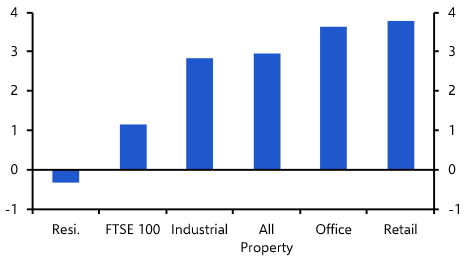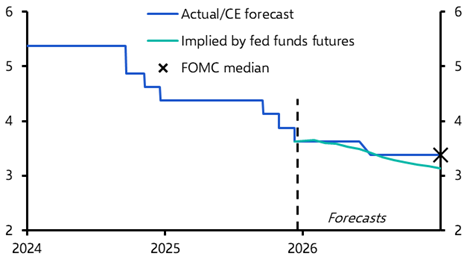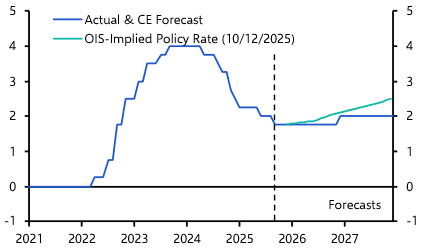Concerns about inflation remain front and centre of investors’ minds and seem likely to dash hopes of a quiet summer. The most immediate concern is the extent to which inflation will rebound as economies “reopen”. This will be influenced by several factors, including the relative speed at which demand recovers and supply is restored, the extent to which any resulting price pressures are absorbed in firms’ margins, and the degree to which the rebound in global commodity prices over the past year is sustained.
We set out a framework for thinking about all of this – and navigating the data distortions caused by the pandemic – here. One conclusion was that the US was likely to experience a much larger rebound in inflation than other advanced economies. That has so far been true, although it’s fair to say that the speed of the rebound in inflation in the US and to some extent the euro-zone has been stronger than even we had anticipated.
The rise in inflation so far has largely reflected a combination of a rebound in commodity prices and what we have termed “reopening” inflation – that is to say, a rebound in prices caused by the unwinding of pandemic-era distortions. These should prove transitory, and we expect inflation in every major economy to drop back next year.
However, lurking in the background is a more fundamental concern that the pandemic will spell the end of the low inflation era of the past thirty years and mark the start of a period of structurally higher inflation over the medium term. The “rebirth of inflation” will be the theme of our annual conference this year, which once again will take the form of a series of short, punchy, virtual events held during September and October. Over the coming months we will be publishing a series of pieces exploring key aspects of the inflation debate.
One way to think about whether we are now witnessing the “rebirth” of inflation is to consider the causes of its “death” in the preceding decades. Broadly speaking there were three.
The first was a huge expansion in supply potential at a global level. The most important aspect of this was the integration of China into the world trading system. But it was also underpinned by new technologies that, for example, enabled the fragmentation of supply chains, as well as a wave of liberalising reforms that led to a more general intensification of competitive pressures.
The second factor was a determination by governments and central banks to bear down on inflation itself. This played out in different ways in different countries. But a key element was that decisions over monetary policy were made separately from government by newly independent central banks, and very often in strict accordance with inflation targets. Policy was set in a restrictive way if necessary, which both brought down inflation but also anchored inflation expectations at lower levels.
The final cause was a structural change in wage- and price-setting behaviour. Price controls were abandoned, and a combination of labour market liberalisation and de-unionisation reduced workers’ bargaining power. This helped to break the wage-price spirals that fuelled a rise in inflation in the 1970s and set it on a lower path.
All of these factors then fed off one another in a mutually reinforcing way to produce the era of low inflation that has been a hallmark of the global economy over the past three decades. But some of the key pillars of the low inflation era are now starting to weaken.
The huge expansion of global supply potential has slowed. Globalisation has peaked and in some ways is reversing, and demographic changes are weighing on labour force growth in many advanced countries. More fundamentally, at some point it is always possible to overwhelm supply with demand. The possibility of this happening has increased substantially following the large build-up of private savings and huge fiscal expansions seen during the pandemic. The risks are particularly acute in the US.
The attitude of governments and central banks is also shifting. After a decade in which deflation has posed a greater threat than inflation, the imperative to continue bearing down on inflation has diminished. The Fed has shifted to an average inflation target and is putting more emphasis on the “full employment” part of its dual mandate. It remains to be seen what this means in practice, or whether other major central banks will follow in the Fed’s footsteps. But at face value this appears to be a break from the past – and more radical changes to policy frameworks could follow.
At the same time, however, powerful headwinds to inflation remain. Globalisation may have peaked but the wave of reshoring that was promised by President Trump has failed to materialise. Labour markets remain highly flexible and the challenges of organising labour in the modern economy continue to limit workers’ bargaining power. And the pandemic has accelerated the adoption of new digital technologies that may in time create a new wave of disinflationary pressure.
The result is a more nuanced picture than the current polarised debate on inflation suggests. Both the survey data and the hard data on inflation look concerning but in most cases still reflect “reopening” pressures that should ease over time. There are reasons to be concerned about a rise in inflation over the medium-term, but the risks are spread unevenly between countries. And while some of the pillars of the low inflation era are weakening, others remain. We’ll be exploring all of this – and the implications for financial markets – in our forthcoming work.




